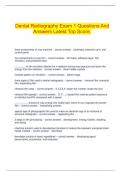Dental Radiography Exam 1 Questions And
Answers Latest Top Score.
three components of xray machine - correct answer. tubehead, extension arm, and
control panel
four components of xray film - correct answer. film base, adhesive layer, film
emulsion, and protective layer
________ in film emulsion absorb the x-radiation during xray exposure and store the
energy from the radiation - correct answer. silver halide crystals
invisible pattern on emulsion - correct answer. latent image
three types of film used in dental radiography - correct answer. intraoral film, extraoral
film, duplicating film
intraoral film sizes - correct answer. 0,1,2,3,4--larger the number, larger the size
intraoral film speeds - correct answer. D, F......f speed film reduces patient exposure
to radiation by 60% compared with d speed
__________ transform xray energy into visible light, which in turn exposes the screen
film - correct answer. intensifying screens
special type of photographic film used to make an identical copy of an intraoral or
extraoral radiograph - correct answer. duplicating film
5 steps in film processing - correct answer. development, rinsing, fixation, washing,
and drying
chemical solution used in development process to reduce the exposed, energized silver
halide crystals - correct answer. developer
developer solution 4 basic ingredients - correct answer. developing agent,
perservative, accelerator, and restrainer
, fixer solution 4 basic agents - correct answer. fixing agent, preservative, hardening
agent, and acidifier
disease transmission may occur as a result of - correct answer. direct contact with
pathogens in saliva, blood, respiratory secretions, lesions...indiret contact with
contaminated objects or instruments....direct contact with airborne contaminants present
in spatter or aerosols or oral and respiratory fluids
3 conditions for infection control to occur - correct answer. susceptible host, pathogen
with suffiencient infectivity and numbers to cause infection
minimum ppe's - correct answer. protective attire, care of hands
film is placed in mouth, parallel to long axis of tooth, central ray is directed
perpendicular to film and long axis of tooth - correct answer. paralleling technique
anterior teeth film size - correct answer. 1
posterior teeth size film - correct answer. 2
5 basic rules of paralleling technique - correct answer. film must cover prescribed
area, film positioned parallel to long axis of tooth, central ray directed perpendicular to
film and long axis of tooth, central ray directed through contact areas between teeth,
and xray beam centered over film to ensure all areas of film are being exposed
which teeth should you always start with in paralleling technique - correct answer.
anterior
advantages of paralleling technique - correct answer. produces images with
dimensional accuracy,simple and easy to learn and use, easy to standardize, and can
be accurately repeated
bisecting technique used to expose - correct answer. periapical films
in bisecting technique: - correct answer. film placed along lingual surface of tooth,
where film contacts tooth-plane of film and long axis of tooth form an angle, imaginary
bisector divides the angle in half or bisects it, and central ray of xray beam is directed
perpendicular to the imaginary bisector
film size used with bisecting - correct answer. 2--positioned vertically for anterior and
horizontally for posterior
incorrect horizontal angulation results in - correct answer. overlapping
correct vertical angulation has the tooth... - correct answer. the same size as the film




